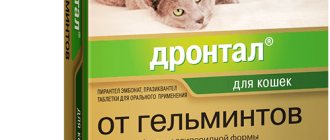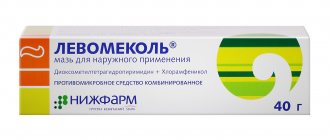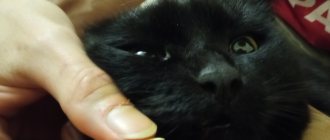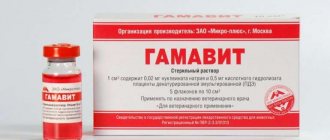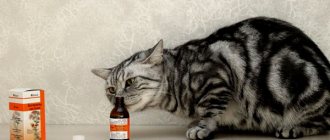How to give a cat a pill
Any pet will resist when a pill is forcefully given to it. This is completely natural behavior. Therefore, certain knowledge and skills are required. We will analyze in detail how to give the medicine correctly so that your pet does not scratch you or cause harm to itself.
- The whole tablet. With his left hand he pulls the skin towards the withers, while raising his head. The mouth will open on its own. Closer to the root of the tongue, cats have no teeth, so that’s where we put the product. We close and fix the mouth until he swallows it.
- Diluted in water. Initially, you need to crush the tablet into powder and dilute it in 3-5 ml. boiled cooled water. We draw the prepared solution into a syringe. We take the pet in our arms and sit it on our knees. With our left hand we hold the pet’s head and at the same time pull the edge of the mouth towards the back of the head with our fingers. With your right hand, insert the syringe into the oral cavity into the free space between the gums (they have no teeth at the edges of the gums) and pour in the prepared product. We hold the pet in this position until he swallows the medicine.
- Enema. This option is suitable if more than 2 hours have passed since the poisoning and the pet has a gag reflex, since the toxic substances have already penetrated the intestines. Grind the tablet and dissolve in 100 ml of water. We collect the resulting solution into a children's rubber enema. We lay the household member on his side. We treat the tip of the syringe with Vaseline and insert it in a spiral motion into the opening of the anus: 2 cm for an adult, 1 cm for a kitten. Introduce the suspension slowly so as not to damage the rectum. Afterwards we hold the animal for 15 minutes. To carry out the act of defecation, we place it in a wide tray.
Treatment of poisoning in a veterinary clinic
Before starting to treat a cat with poisoning, the doctor must obtain from the owner information about what, in the owner’s opinion, the cat was poisoned with, whether there was vomiting (it would be a good idea for the owner to take a sample of the vomit with him), whether there was diarrhea, what chronic diseases your cat has, and etc. A quick clinical examination is carried out and resuscitation measures begin.
The cat is given a drip with 40% glucose. General stimulants (Gamavit, Katazol, Vitam, Vitamin C) and detoxifying drugs, hepatoprotectors (Essentiale), cardiac drugs (camphor, caffeine, cordiamine), antiemetics (Cerucal), and antidiarrheal drugs are administered intravenously. In case of severe poisoning, the drip to the cat is repeated every other day.
To normalize water-salt metabolism, the cat is injected intravenously with Ringer's solution. When treating poisoning, veterinary specialists also use antispasmodics - no-shpa, baralgin.
In order to speed up the elimination of poisons that have entered the body, diuretics are prescribed.
Depending on the general condition of the body, a veterinarian may additionally resort to symptomatic treatment.
Dose of activated carbon
The required dose is calculated based on the weight of the adult pet. The recommended dose per 10 kg of weight is 0.25 g. main active ingredient, that is, 1 tablet. The drug should be used every 4 hours up to 4 times a day.
The medication should not be given for more than 7 days, regardless of the pet’s age.
Dosage
Rules for taking the drug
Veterinarians are confident that charcoal does not cause harm to pets and practically does not cause any negative reactions, so animals should take it. If it is not possible to contact a veterinarian at first, the owner must provide first aid to the pet.
Admission rules:
- First you need to move the animal to fresh air or open a window to allow air to enter.
- Then try to determine what caused the poisoning. If poison gets on the animal's fur, it should be washed off with cool water and soap.
- Then give the cat a sorbent.
- In order for the drug to be better absorbed, it must be crushed, diluted with a small amount of water, then stirred and given to the cat.
- It is better to introduce it into the mouth using a spoon or syringe, removing the needle from it.
- If you have an appetite, activated charcoal can be mixed with food given to your pet.
If your pet refuses to swallow the drug, you should take a blanket and wrap the animal so that it does not break out or scratch it with its claws. First you need to wrap the neck, then the paws. Then the entire body is twisted, leaving only the protruding muzzle. After this, the cat’s mouth is opened and the sorbent is introduced. If the cat is unconscious, you should not try to give medication; you must call a veterinarian.
During poisoning, the pet needs drinking water, because... it, together with charcoal, will promote the rapid elimination of toxic substances, reduce the load on the kidneys and liver, and prevent the process of dehydration of the cat’s body.
Some veterinarians believe that this drug can be used in pets and as a preventative measure, in order to avoid digestive disorders in the gastrointestinal tract, if the cat does not live at home, but on the street or often walks there. To do this, the absorbent is crushed and poured into the pet's food.
An animal that has received food poisoning must be under the supervision of the owner; if the condition is bad, it is forbidden to give food or influence the process of diarrhea and vomiting, because it is a natural way of eliminating toxins.
If vomiting and diarrhea more than 7-8 times a day, then you should be wary and seek help from a specialist.
It should be borne in mind that the use of charcoal for diarrhea will only act on the elimination of poisons; the drug will not have an effect on the process of peristalsis and the speed of the digestion process. The medication is perfect for treating mild poisoning; for severe problems, it alone will not be enough. In the first stages of poisoning, combining the drug with Smecta or Atoxil is allowed.
Contraindications and side effects
The main contraindications for use are:
- peptic ulcer;
- stomach and intestinal bleeding;
- intolerance to the components of the medication;
- diabetes;
- allergy to starch.
With prolonged use of the medicine, undesirable consequences may develop. These include:
- constipation;
- adsorbs a large amount of vitamin, which leads to vitamin deficiency in the animal;
- leads to a decrease in the acidity of gastric juice.
Activated carbon
The drug and the bite of the blister beetle
In addition to banal poisoning, diarrhea and vomiting in a cat can be caused by other reasons. One of them is the bite of a blister beetle. This small and seemingly harmless insect is very dangerous for small animals, since its bite in certain situations can even kill a horse.
The thing is that the body of this beetle contains poison, which, if it comes into contact with the skin, leads to a burn and the subsequent formation of characteristic blisters. If you notice such a blister on your pet's skin, you should immediately take him to the veterinarian. But before that, be sure to give your cat activated charcoal, which will fight the infection while you are on the road.
Prevention of poisoning in cats
For preventive purposes, the medicine is prescribed 1 tablet per day, by mixing it with food. Before adding it, it must be crushed into powder and mixed into food in small portions throughout the day, so that the pet does not sense the presence of the medicine.
Also, for the purpose of prevention, certain points that can provoke poisoning should be observed:
- It is not recommended to grow poisonous plants at home;
- medicines and household chemicals should be kept out of the reach of your pet;
- do not leave food that is not intended for animal consumption unattended;
- close the trash can tightly;
- carry out preventive measures against fleas and ticks in a timely manner, but only with products for cats and taking into account weight (replacing the medicine with an analogue for dogs can provoke poisoning).
To summarize, we can say that activated charcoal can be given to a cat at the first symptoms of poisoning. However, if there is no improvement within 24 hours or if the pet becomes worse after taking it, then you should contact a veterinary clinic to prescribe effective treatment.
When does a cat need activated charcoal?
The drug is obtained from charcoal powder; starch and sucrose are added to form tablets.
It absorbs toxic substances from the gastrointestinal tract, does not break down, and is not absorbed into the blood. After a day, it is completely excreted along with feces. Doctors prescribe charcoal in the following cases:
- poisoning with food, drugs, chemicals;
- food infections: salmonellosis, dysentery;
- stomach diseases, which are accompanied by flatulence and bloating;
- renal failure;
- diarrhea after deworming;
- allergies to food, medications.
Without a doctor's prescription, the drug is given at the first signs of poisoning:
- nausea, vomiting and diarrhea;
- weakness;
- increased salivation;
- dilated pupils;
- labored breathing;
- fever;
- impaired coordination of movements.
The drug will be needed when at least two symptoms appear: the sooner it gets into the gastrointestinal tract, the faster the spread of toxins throughout the body will stop. For prevention, charcoal is given when it is suspected that the cat has swallowed stale food or licked a toxic substance. The drug can be used for pregnant and lactating cats.
Prevention of diarrhea during antibiotic therapy
To prevent diarrhea while taking antibiotics, it is important to follow several recommendations:
- strictly adhere to the dosage and treatment regimen prescribed by the doctor;
- use probiotics recommended by a specialist;
- follow a diet to prevent gastrointestinal disorders;
- maintain optimal drinking regime;
- take medications that protect the lining of the stomach and the entire digestive tract. If you have chronic ailments, you must inform your doctor about them so that he can select an individual scheme for protecting the digestive system from the effects of antibiotics.
If it is necessary to take antibiotics, it is important to take into account the body's previous reactions to antibacterial therapy. Thus, in some patients, antibiotic-associated diarrhea develops in response to exposure to a particular group of drugs or a specific agent.
Publications in the media
Neuroleptics (for example, phenothiazine derivatives - chlorpromazine, promazine, levomepromazine, prochlorperazine, trifluoperazine) belong to the group of psychosedatives. Detoxification in the liver, excretion through the intestines and urine - no more than 8% of the dose taken for 3 days. Recently, the number of cases of overdose and poisoning of drugs in this group has been growing. Toxic dose is more than 500 mg. Lethal dose 5-10 g. Toxic concentration in the blood - 1-2 mg/l, lethal - 3-12 mg/l.
Etiopathogenesis • Toxic effect: psychotropic, neurotoxic (gangliolytic, adrenolytic effects; inhibition of the reticular formation of the brain; damage to the thalamocortical system) • Histologically, signs of hypoxia predominate in the form of widespread ischemic changes in neurons, the formation of homogeneous coagulates in the vessels and pronounced dystrophic changes in astrocytic glia with the appearance of amoeboid cell forms. Clinical picture . The main stages are the same as for poisoning with hypnotics and tranquilizers (see Poisoning with hypnotics and tranquilizers) • Severe weakness, dizziness, severe dry mouth, nausea • Decreased or absent reaction of the pupils to light with relative preservation of corneal reflexes (in 70 -80%), convergence disorder • Neurological disorders •• Ataxia, decreased tendon and periosteal reflexes, muscle spasm, trismus of masticatory muscles, convulsions •• Akinetic-rigid syndrome, features: dissociation of symptoms - severe hypomimia and hypokinesia without a significant increase in muscle tone ( muscle hypotonia is observed in 50% of cases) •• Hyperkinetic syndrome - a combination of several types of hyperkinesis (torticollis, oral hyperkinesis, tremor of the hands) or the replacement of one hyperkinesis by another (choreiform chill-like or large-amplitude tremor of the hands) •• Reactions to painful stimuli are preserved (in 75 %) • Increased heart rate, decreased blood pressure without cyanosis • When taken orally - hyperemia and swelling of the oral mucosa, in children - severe irritation of the gastrointestinal mucosa • Skin allergic reactions • Comatose state - shallow, hypothermia, increased tendon reflexes; upon recovery from coma, parkinsonism and orthostatic collapse are possible • In some cases (as a result of blockade of dopamine receptors), the development of neuroleptic malignant syndrome is possible: hyperthermia with extrapyramidal and autonomic disorders that can lead to death (Deley-Deniker syndrome).
Diagnostics • Spectrophotometric method for determining a toxic substance in the blood • EEG • ECG - sinus tachycardia, decrease in ST below the isoline, negative T wave. Differential diagnosis - see Poisoning with hypnotics and tranquilizers.
TREATMENT Management tactics (see also Poisoning with hypnotics and tranquilizers) • Gastric lavage through a tube followed by the introduction of a sorbent (activated carbon), emetics • Subsequently - infusion therapy, forced diuresis without alkalization of the blood • Hemosorption (2-3 times reduces duration of the comatose period) • Symptomatic therapy : elimination of severe respiratory and hemodynamic disorders, relief of convulsive syndrome, elimination of complications. Drug therapy • Diphenhydramine 2-3 mg/kg IV or IM to suppress extrapyramidal symptoms • Analeptics (camphor, nickamide, caffeine, ephedrine) - only for superficial coma. In all other cases, they are strictly contraindicated (development of convulsive conditions and respiratory complications). Complications - see Poisoning with sleeping pills and tranquilizers. Prognosis (see also Poisoning with hypnotics and tranquilizers) • Asthenic syndrome persists even 2–3 years after intoxication • Long-term persistence of parkinsonian syndrome (even 2–3 years after poisoning) • Patients require long-term observation and treatment after discharge from the hospital .
ICD-10 • T43.3 Poisoning with antipsychotic and antipsychotic drugs
Treatment of antibiotic-associated diarrhea
Diarrhea that develops while taking antibiotics requires adjustment of the treatment regimen. You should not stop taking medications on your own; you should consult your doctor. Typically, the course of antibacterial therapy is interrupted or the drug is replaced with an antibiotic of a different group.
Normalization of digestive processes, intestinal motility and stool consistency are tasks that require an integrated approach. There are three general principles that are important for all people suffering from diarrhea after taking antibiotics:
- Nutrition correction: it is important to follow a diet. The diet should include crackers and rice water. It is important to reduce the amount of carbohydrates consumed as much as possible, and also give up milk, dairy products, baked goods, fresh vegetables, berries and fruits; legumes, pasta.
- Compliance with the drinking regime: it is necessary to drink at least 2 liters of water per day to replenish fluid loss during watery stools.
- Symptomatic therapy: the pathological process can be stopped with the help of medications.
Due to the fact that many sources of natural probiotics and prebiotics are prohibited for diarrhea, one of the key principles of treatment is the prescription of medications containing these components. Strict dietary restrictions require the use of probiotics and prebiotics for antibiotic-associated diarrhea: it is important to restore normal intestinal microflora to prevent the proliferation of opportunistic microorganisms.
In most cases, medication correction is indispensable. Remember that only a doctor can prescribe medications.
There are several groups of drugs that can be recommended for antibiotic-associated diarrhea.
Sorbents
Infectious and inflammatory diseases are accompanied by intoxication of the body, and in the process of antibacterial therapy, decay products of pathogenic microflora accumulate. Therefore, the doctor may prescribe enterosorbents - products that literally absorb toxins and harmful substances and remove them from the body.
Probiotics and prebiotics
It is important to address the root cause of diarrhea and restore normal intestinal microflora after taking antibiotics. For this, probiotics are used - bifidobacteria, lactobacilli, as well as prebiotics - a nutrient substrate to stimulate the growth of one's own beneficial microflora. Synbiotics include both probiotics and prebiotics and are widely used in gastroenterological practice.
If there is a pronounced shift in the microbial balance, the doctor may recommend intestinal antiseptics or bacteriophages - they are designed to prevent the growth of opportunistic microflora and help restore the number of beneficial microorganisms.
Enzymes
Enzyme replacement therapy is not the mainstay of treatment for antibiotic poisoning. However, preparations based on digestive (pancreatic, gastric, intestinal) enzymes stimulate the digestion of food, normalize intestinal motility and peristalsis and participate in the restoration of normal microflora of the large intestine.
Symptomatic therapy
Diarrhea is often accompanied by painful symptoms: flatulence, nausea, cramping and abdominal pain. You can quickly alleviate the condition with the help of medications. They are unable to cope with the main problem, but will bring temporary relief. Report your symptoms to your doctor, and he will select one or more remedies to improve your well-being:
- for increased gas formation - defoamers (drugs based on simethicone) or herbal carminatives;
- analgesics or antispasmodics for pain;
- Oral rehydration solutions are products designed to replenish normal fluid volume and prevent dehydration.
If diarrhea is accompanied by elevated body temperature, the doctor will select an antipyretic drug.
General strengthening agents
Weakened by an infectious or inflammatory disease, as well as subsequent use of antibiotics, the body may require complex recovery. A specialist can prescribe immunomodulators, vitamin-mineral complexes and restorative drugs.
Restrictions in food during diarrhea can also cause hypovitaminosis and lack of minerals. During long-term antibiotic therapy, it is necessary to discuss preventive measures with your doctor in advance.
Antidiarrheal drugs
If you cannot cope with diarrhea, your doctor may prescribe drugs from the following groups:
- eubiotics - live bacteria that are designed to restore the balance of intestinal microflora and restore normal digestive function;
- synthetic drugs based on loperamide: bind to opioid receptors of the intestinal wall and inhibit the release of mediators that stimulate intestinal motility;
- herbal preparations based on tannins.
Sorbents also have an antidiarrheal effect. They are natural and synthetic. Enterosorbents, entering the intestines, absorb toxins and harmful substances, contribute to the formation of stools and their reduction. It is important to remember that at least two hours should pass between taking sorbents and other drugs.
For severe antibiotic-associated diarrhea, antibacterial agents targeting Clostridium difficile or another infectious agent may be appropriate.
The drug “Fitomucil Sorbent Forte” can be used as an adjunct to relieve diarrhea syndrome. It contains inulin, a prebiotic that promotes the growth of normal microflora, as well as 5 types of probiotic bacteria. In addition, the drug contains psyllium, a natural component that helps reduce diarrhea and relieve intoxication, since it turns into a gel and absorbs toxins. The triple effect (enterosorbing, detoxifying and restorative) distinguishes Fitomucil Sorbent Forte from other sorbents prescribed for AAD. Live bacteria populate the intestines and not only help relieve diarrhea, but also improve the condition of the microflora that has been damaged by taking antibiotics.
However, to restore microflora it is not enough to take one drug.
Only a doctor prescribes specific therapy. It is necessary to stop taking uncontrolled medications and agree with a specialist on medications for symptomatic therapy.




